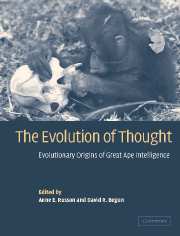Book contents
- Frontmatter
- Contents
- List of Contributors
- Preface
- 1 Evolutionary reconstructions of great ape intelligence
- 2 Enhanced cognitive capacity as a contingent fact of hominid phylogeny
- PART I COGNITION IN LIVING GREAT APES
- PART II MODERN GREAT APE ADAPTATION
- PART III FOSSIL GREAT APE ADAPTATIONS
- Introduction
- 13 Paleoenvironments and the evolution of adaptability in great apes
- 14 Cranial evidence of the evolution of intelligence in fossil apes
- 15 Life history and cognitive evolution in the apes
- 16 Fossil hominoid diets, extractive foraging, and the origins of great ape intelligence
- 17 Paleontology, terrestriality, and the intelligence of great apes
- 18 Body size and intelligence in hominoid evolution
- Part IV INTEGRATION
- Author index
- Species index
- Subject index
17 - Paleontology, terrestriality, and the intelligence of great apes
Published online by Cambridge University Press: 20 August 2009
- Frontmatter
- Contents
- List of Contributors
- Preface
- 1 Evolutionary reconstructions of great ape intelligence
- 2 Enhanced cognitive capacity as a contingent fact of hominid phylogeny
- PART I COGNITION IN LIVING GREAT APES
- PART II MODERN GREAT APE ADAPTATION
- PART III FOSSIL GREAT APE ADAPTATIONS
- Introduction
- 13 Paleoenvironments and the evolution of adaptability in great apes
- 14 Cranial evidence of the evolution of intelligence in fossil apes
- 15 Life history and cognitive evolution in the apes
- 16 Fossil hominoid diets, extractive foraging, and the origins of great ape intelligence
- 17 Paleontology, terrestriality, and the intelligence of great apes
- 18 Body size and intelligence in hominoid evolution
- Part IV INTEGRATION
- Author index
- Species index
- Subject index
Summary
INTRODUCTION
The level of intelligence among great apes (orangutans, gorillas, chimpanzees, and bonobos) has produced an astonishing array of phenomena to explore. Great apes are believed to be self-aware, social manipulators, makers and users of tools, and generally good problem solvers (e.g., Boesch & Boesch 1984; Byrne 1995; Byrne & Whiten 1988, 1991; de Waal 1989; Gallup 1970, 1991; Goodall 1986; Kohler 1925; McGrew 1992; Parker, Mitchell & Boccia 1994; Premack 1988; Russon, Bard & Galdikas 1996, Russon et al. 1998). In contrast, other primates such as gibbons or monkeys show lesser abilities in these tasks (e.g., Anderson 1984; Byrne 1995; Cheney & Seyfarth 1990; Gallup 1991; Povinelli 1987; Povinelli & Cant 1995; Visalbergi & Trinca 1987). Two types of explanation, ecological and social, have been used to explain this dichotomy.
Ecological explanations have attempted to explain increased brain size among primates as a function of enhanced cognitive skills to increase foraging success (Clutton-Brock & Harvey 1980; Gibson 1986; Milton 1988; Parker & Gibson 1977; Povinelli & Cant 1995). For example, Clutton–Brock and Harvey (1980) and Milton (1988) have both shown that frugivory and increased brain size are correlated. Milton (1988) suggested that the complex mental–spatial maps used to find food among fruit-eating primates may play a significant role in increasing intellectual abilities.
- Type
- Chapter
- Information
- The Evolution of ThoughtEvolutionary Origins of Great Ape Intelligence, pp. 320 - 334Publisher: Cambridge University PressPrint publication year: 2004
- 6
- Cited by



